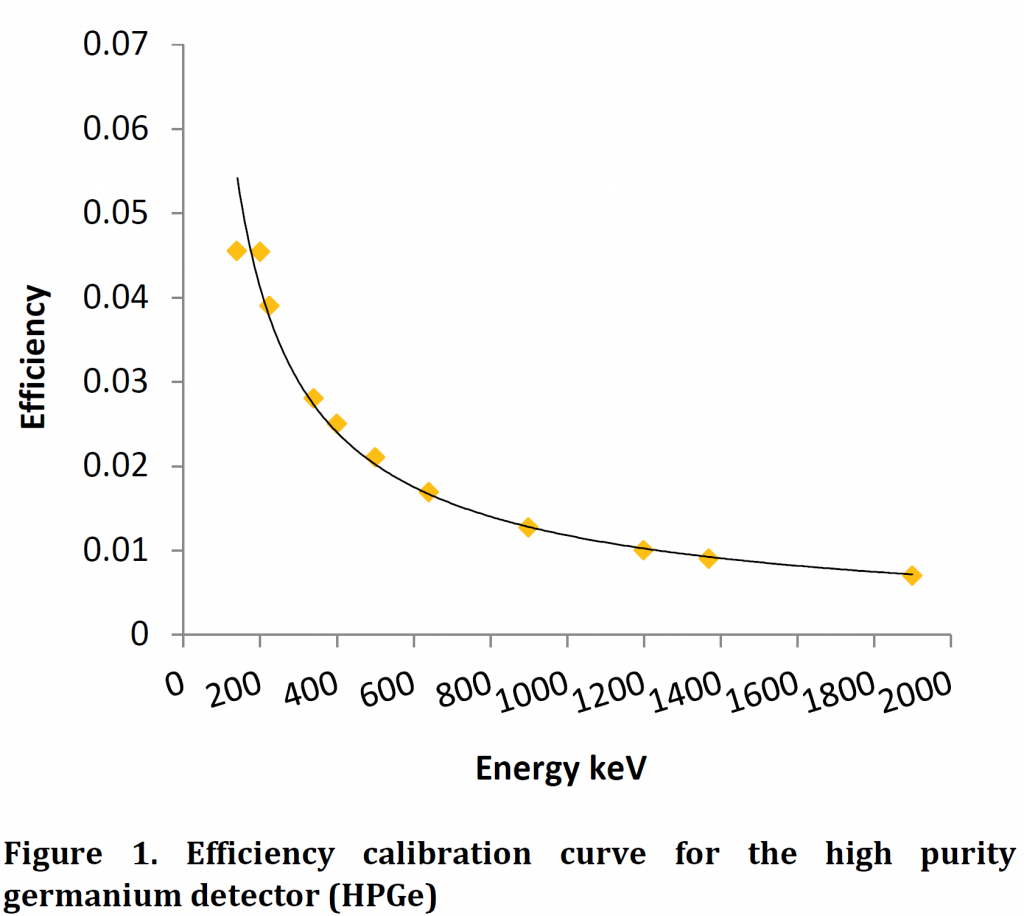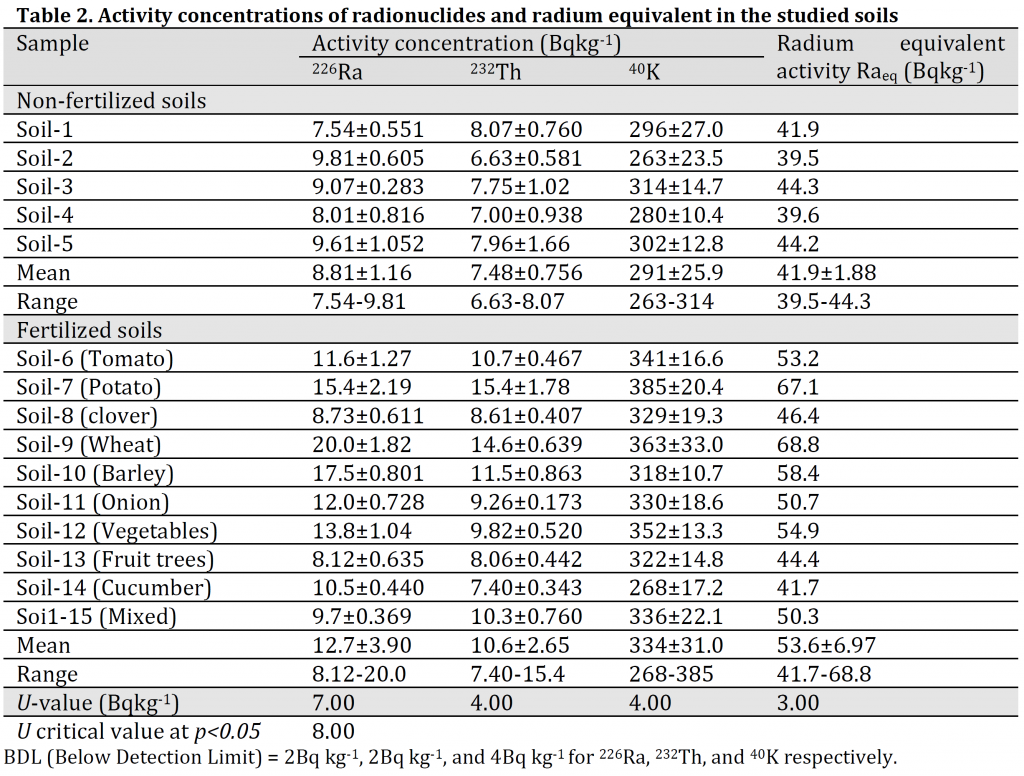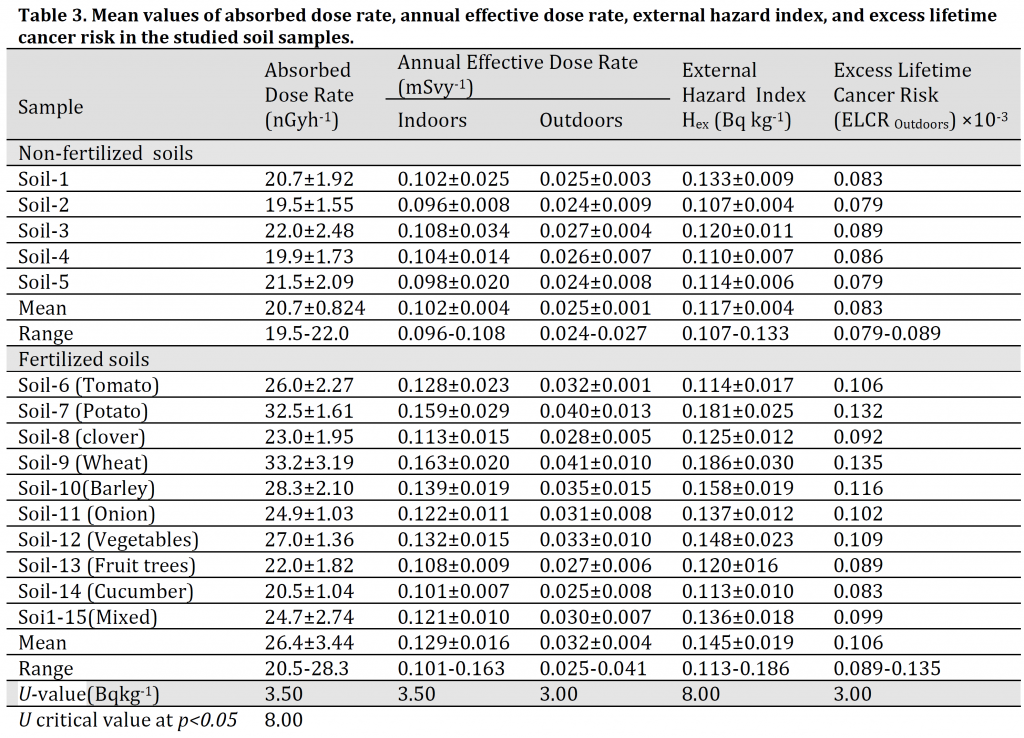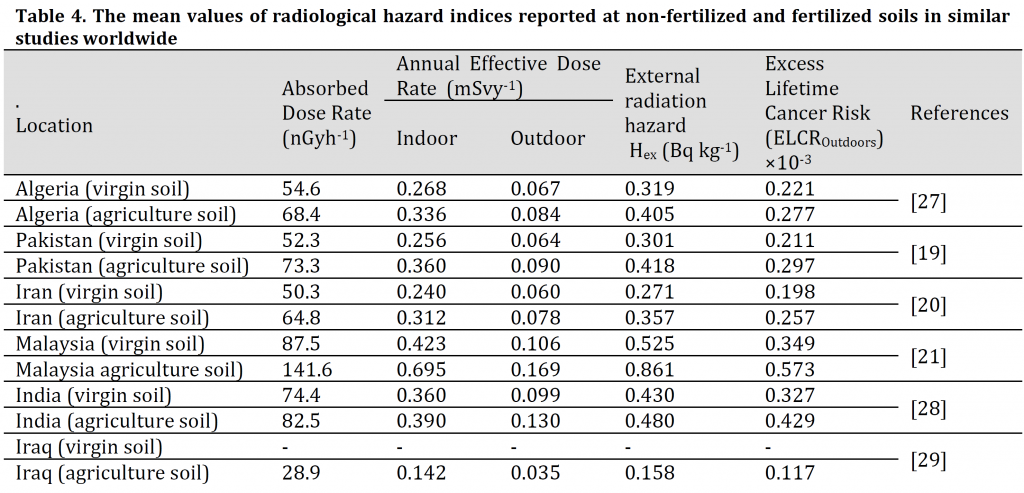Neymea G. Al-Mousawi1; Raghad S. Mouhamad2*; Naseer A. AlSaadie2
1, Radiation and Nuclear Safety Directorate, Ministry of science and Technology, Baghdad, Iraq
2, Agricultural Research Directorate, Ministry of Science and Technology, Baghdad, Iraq
E-mail:
raghad1974@yahoo.com
Received: 05/06/2020
Acceptance: 26/06/2020
Available Online: 28/06/2020
Published: 01/07/2020

Manuscript link
https://dx.doi.org/10.30493/das.2020.237227
Abstract
The excessive use of fertilizers has become a necessity to support agricultural production in vast areas in Iraq. Phosphate fertilizers are known to contain relatively high concentrations of uranium‐238 (238U), radium‐226 (226Ra), thorium‐232 (232Th), and potassium‐40 (40K) radionuclides which accumulate in soil with time. In the current study, gamma-ray spectrometry was used to measure the radioactivity concentration of naturally occurring radionuclide in fertilized and non-fertilized soil samples within Latifiyah region in Iraq. The results showed that the average concentrations of 226Ra, 232Th, and 40K in fertilized soil were 12.7, 10.6, and 334 Bqkg-1 respectively which was 30.6%, 29.4%, and 12.9% higher than its concentration in non-fertilized soils with 8.81 7.48 and 291 Bqkg-1. Additionally, the average values of radium equivalent activity (Raeq), absorbed dose rates ???? (nGyh−1), annual effective dose (indoors and outdoors), external hazard index (????ex), and Excess Lifetime Cancer Risk (ELCR) for fertilized and non-fertilized soils samples were evaluated. The results showed that the studied indices were 53.6 Bqkg−1, 26.4 nGyh−1, (0.129 and 0.032 mSvy−1), 0.145 Bqkg-1, 0.106 respectively in fertilized soils compared to 41.9 Bqkg−1, 20.7 nGyh−1, (0.102 and 0.025 mSvy−1), 0.113 Bqkg-1, 0.084 in non-fertilized samples. The Mann-Whitney U test showed a significant difference (P<0.05) between the studied fertilized and non-fertilized soils in terms of radioactivity concentrations in addition to all the investigated radiation hazard indices. However, the mean values of radioactivity concentrations and radiological hazard indices for study soils were well below the internationally recognized and therefore, fertilizer rates did not pose any radiological risk.
Keywords: Phosphate Fertilizers, Natural radionuclides, Gamma spectrometry, Radiation Hazard Indices
Abbreviations: The average values of radium equivalent activity (Raeq), The external hazard index (????ex), Excess Lifetime Cancer Risk (ELCR)
Introduction
The continuous growth in the world population raised the need for agricultural productions to increase. This increase cannot be fulfilled without the use of fertilizers. These fertilizers are used around the world and usually in extensive amounts to increase crop production. Phosphorus fertilizers are essential for plant nutrition. These fertilizers are manufactured from phosphate rock. The crucial point about phosphate fertilizers that is usually overlooked, is their relatively high content of uranium‐238 (238U), radium‐226 (226Ra), thorium‐232 (232Th), and potassium‐40 (40K) radionuclides in addition to various heavy metals [1-6]. These elements accumulate in the soil through years of extensive usage and might generate a serious environmental hazard [7-11]. Therefore, it is highly important to assess the radiological hazards of phosphate fertilizers usage [12][13].
Previously, various studies concentrated on the potential risks of cultivating or being exposed to lands fertilized excessively with phosphate fertilizers. For example, [13] found that the average concentrations of 40K, 238U, and 232Th were significantly higher in fertilized areas compared to areas where no fertilizers were used. The impact of NPK fertilizer on the activity concentration in sugar beet crop and soil has been studied by [14] they concluded that there was a positive relationship between the content of 226Ra, 232Th, and 40K in both soil samples and sugar beetroot with the added phosphate fertilizers rate.
In Iraq, phosphate fertilizers use has resulted in an outstanding increase in agricultural production. Therefore, its consumption has increased rapidly in the last years, mainly due to the high yield generated from using low-cost fertilizer. This increased use of phosphate fertilizers, especially imported ones that are rich in natural radionuclide, resulted in a change in the radiological level of the Iraqi soil which varied based on usage rates [15].
Taking into consideration the aforementioned facts, it is fundamental to evaluate the radiological risk of fertilizers in Iraqi agricultural soils from a health point of view. Therefore, the current study aimed to assess the effect of fertilizers on the soil radiation level and to evaluate the possible health hazards attributed to these soils to persons working in the fields.
Material and Methods
Soil samples
The experiment was carried out in the Latifiya region, agricultural research station of the Department of Agricultural Research, 35 km south of the capital, Baghdad-Iraq. Soil samples were collected from 15 non-fertilized and fertilized agricultural locations in the region. Different crops were grown in the fertilized land (10 locations in total) and variety of fertilizers types were used such as Ammonium phosphate Mono-ammonium phosphate (MAP), Di-ammonium phosphate (DAP), Triple Super Phosphate (TSP), and Nitro Phosphate Potash (NPK) of both Iraqi sources and imported. All crops were cultivated under the fertilizer application recommended by local farmers to improve crop productivity. Samples were also collected from 5 non-fertilized (fallow) lands where no crop was grown for many years. Soil samples were collected from depths of 0-30 cm. Soil samples were packed in polyethylene bags and transferred to the laboratory. Plant roots and stones were separated from the samples. The samples were then dried under sunlight for two days to remove the moisture and then in an oven at 105°C for 24 h until fixed weights were reached. The samples were homogenized by grinding and sieving through a 2 mm mesh. The sieved soil samples (1 kg) were transferred into Marinelli Beaker plastic containers which were then sealed with plastic tape to prevent airflow from the samples and stored for one month before measurements, thereby, allowing the Bismuth 21Bi and the Thallium 208Tl to reach a general equilibrium with Uranium 238U and 232Th and their respective daughters and to ensure that the radon 222Rn and 220Rn are confined within the volume.
Radioactivity measurement
The natural radioactivity concentrations for the collected soil samples were measured with a high purity germanium detector (HPGe) connected to a multichannel analyzer with high voltage. The gamma spectrometry was enclosed by a cylindrical lead shield. Gamma energy and efficiency of the system was calibrated using a standard gamma source from the International Atomic Energy Agency (60CO, 137Cs, 22Na, 241Am, and 226Ra).
The activity concentrations of 226Ra, 232Th, and 40K were then calculated using the equation [16]:

the efficiency of the gamma spectrometer at the respective gamma energy (εγ) (Fig. 1) was calculated using the polynomial fitting method [17][18]. The gamma energy lines which were used to determine the activity concentrations of 226Ra, 232Th, and 40K, and their corresponding absolute transition probability (Pγ) are shown in (Table 1). The total uncertainties in the activity concentration were calculated by adding the statistical uncertainties of the gamma counting, uncertainties in sample weight 0.01, uncertainties in efficiency calibration 0.05%, and uncertainties in probability transition 0.01[18].


The average values of radium equivalent activity (Raeq), absorbed dose rates (nGyh−1), annual effective dose (indoors and outdoors), external hazard index (????ex), and Excess Lifetime Cancer Risk (ELCR) for fertilized and non-fertilized soils samples were calculated. The Mann-Whitney U test at p<0.05 was used to test whether two groups have the same means or not.
Results and Discussion
Natural radioactivity concentrations
The natural radioactivity concentrations of 226Ra, 232Th, and 40K in non-fertilized and fertilized soils, obtained for each of the measured samples ± standard deviation value are showed in (Table 2.). The highest and lowest concentrations of Radium were observed in the soil samples obtained from wheat fields and fruit trees orchards with 20.0 and 8.12 Bgkg-1 respectively. The highest concentrations of 232Th and 40K were measured in soil samples from potato fields with 15.4 and 385 Bqkg-1 respectively, while the lowest concentrations were observed in cucumber soil samples with 7.4 and 268 Bqkg-1 respectively. The activity concentrations in non-fertilized soils varied from 7.54 to 9.81 Bqkg−1 for 226Ra, from 6.63 to 8.07 Bqkg−1 for 232Th, and from 263 to 314 Bqkg−1 for 40K. Results present in (Table 2.) showed that the mean activity concentrations value for 226Ra, 232Th, and 40K in fertilized soil were 12.7±3.90, 10.6±2.65, and 334±31.0 Bqkg-1 respectively. On the other hand, the non-fertilized soils recorded averages were 8.81±1.16, 7.48±0.756, and 291±25.9 Bqkg-1 respectively. Therefore, the calculated percentage differences in 226Ra, 232Th, and 40K activity concentrations between fertilized and non-fertilized soils were 30.6, 29.4 12.9% respectively.

Mann-Whitney U Test at p<0.05 revealed that the mean activity concentrations for 226Ra, 232Th, and 40K in fertilized soil samples were significantly different from those in the non-fertilized soils. Therefore, it can be concluded that the use of fertilizers in these fields has increased the activity concentrations of natural radionuclides. These results of the present studied area corresponded to previously conducted studies by [19][20][21]. Additionally, [22] explained the radioactivity concentrations in agricultural soils caused by fertilizers are higher than those in virgin soils, where the same study indicated that the average activity concentration for 226Ra, 232Th, and 40K were (102, 34.0 and 326 Bqkg−1) respectively in cultivated soils, and (65.2, 83.4 and 137 Bqkg−1) respectively in virgin soils which mean that the values presented in the current studies were lower in both cases. The mean concentrations of 226Ra, 232Th, and 40K obtained in the current study were also lower than the recommendations published in [23].
Radium equivalent activities (Raeq) were calculated to evaluate the radiological risk attributed to the obtained concentrations according to the equation [24]:
Raeq = ARa + 1.43ATh + 0.077Ak (2)
ARa, ATh, and AK are the activity concentrations of 226Ra, 232Th, and 40K (Bqkg-1), respectively. The highest and lowest values of Raeq in fertilized soils were observed in wheat and cucumber (68.8 and 41.7 Bqkg-1) respectively. Overall, the mean Raeq in the fertilized soil samples was 53.6 Bqkg-1, whereas, in non-fertilized soils, it ranged from 39.5 to 44.3 Bqkg-1 with a mean of 41.9 Bqkg-1. From these results, it can be concluded that the radium equivalent activity in the soil samples collected from fertilized soil samples was on average 39% higher than non-fertilized soils. This increase was significant in general according to the obtained U-value at p<0.05. However, the average values of Raeq in this studied soil samples were found to be below the accepted value of 370 Bq Kg-1 recommended by the United Nations Scientific Committee on the Effects of Atomic Radiation (UNSCEAR)[23] Therefore, these values do not impose a radiological hazard to farmers.
Radiological hazard indices
Activity concentrations for 226Ra, 232Th, and 40K measured were converted into doses (nGyh-1 per Bqkg-1) by applying the factors 0.462, 0.604, and 0.0417 to the above nuclides, respectively according to [23]. These factors are used to measure the overall absorbed gamma dose in the air at one meter level above the ground. The outcome parameter can be used to estimate radiological hazard and radiation exposures from radionuclide in the soil using the following equation:
Dose rate (nGy h-1) = (0.462 × CRa+ 0.604 × CTh+ 0.0417 × CK) (3)
Where, CRa, CTh, and CK are the radiological concentrations (Bqkg-1) of the existed 226Ra, 232Th, and 40K respectively. The annual effective dose rate (AEDR) can then were calculated (multiplying by 8760) then, a human effective-dose equivalent conversion factor of 0.7 SvGy-1 was considered with an occupancy of 20% and 80% for indoors and outdoors respectively to calculate the received annual dose [23]:
Indoors (nSvy-1) = Dose rate nGyh-1 × 8760h × 0.7 SvGy-1 × 0.8 (4)
Outdoors (nSvy-1) = Dose rate nGyh-1 × 8760h × 0.7 SvGy-1 × 0.2 (5)
the calculated absorbed dose rate, in addition to the annual effective dose rates indoors and outdoors ranged between 20.5 to 28.3 nGyh-1, 0.101 to 0.163 mSvy-1, and 0.025 to 0.041 mSvy-1 respectively in fertilized soil samples. On the other hand, these parameters ranged between 9.5 to 22.0 nGyh-1, 0.096 to 0.108 mSvy-1, and 0.024 to 0.027 mSvy-1 respectively non-fertilized land (Table 3.). Mann-Whitney U-value showed that the absorbed dose and annual effective dose for the fertilized soil samples were significantly higher than non-fertilized samples (P<0.05). However, the average dose values in the current study were found lower than the normal background radiation estimations of 59 nGyh-1[25]. Additionally, the annual effective dose indoors and outdoors was below the International Commission on Radiological Protection (ICRP) limit of 1 mSvy-1 for the general public [26].

The external radiation hazard index (????ex) (BqKg-1) represents the external radiation exposure associated with gamma irradiation from radionuclides of hazard concern. The resulted ????ex should be less than the maximum acceptable value of 1 to be considered insignificant [23]. This index can be calculated and evaluated using the following semi-empirical formula [23].

External hazard values ranged between 0.113-0.186 in fertilized samples which were below the criterion value (<1). The average external radiation exposure in agricultural soils that used different chemical fertilizers reached (0.145±0.019 Bq kg-1) with a 19.3% increase compared to the average (0.117±0.004 Bq kg-1) of non-fertilized soil samples (Table 3).
Excess lifetime cancer risk (ELCR) was measured using the following formula [23].

Fatal cancer risk per Sievert is 0.05 according to [26]. The ELCRoutdoors ranged from 0.079×10-3-0.089×10-3 with an average value of (0.083×10-3) in non-fertilized soils. On the other hand, it ranged from 0.089×10-3 to 0.135×10-3 with an average of 0.106×10-3 in fertilized soils. The average excess lifetime cancer risk index in fertilized agriculture soils was 20% more than that of non-fertilized soils. This difference was significant according to the Mann-Whitney U test (p<0.05). However, ELCR in fertilized soils was well below the permissible level of 0.29×10-3 [23]. The results of various similar studies can be seen in (Table 4) for comparison with the current study. It can be noticed that the values reported in the current study are lower than those of other studies which might be attributed to lower and more reasonable rates of fertilizer usage in the studied area.

Conclusion
The current study illustrated that 226Ra, 232Th, and 40K were higher in agricultural fertilized soil compared to those in non-fertilized sites in Latifiya region, which underlined the effect of fertilizers in transferring natural radionuclides to the soil. Therefore, radiological hazard parameters were investigated.
The studied radiological hazard parameters: radium equivalent activity, absorbed dose rate, annual effective dose (indoors and outdoors), external hazard index, and excess lifetime cancer risk in agricultural fertilized soil collected were also significantly higher in fertilized soil samples compared to the non-fertilized soils. However, the levels of these indices in both soils were below the reference limits proposed by UNSCEAR.
The current work concludes that fertilizers were being used in reasonable rates and therefore, the radiation status did not pose any threats to the residents.
References
| 1 | Carnelo LG, de Miguez SR, Marbán L. Heavy metals input with phosphate fertilizers used in Argentina. Sci. Total Environ. 1997;204(3):245-50. DOI |
| 2 | Nziguheba G, Smolders E. Inputs of trace elements in agricultural soils via phosphate fertilizers in European countries. Sci. Total Environ. 2008;390(1):53-7. DOI |
| 3 | Abdel-Haleem AS, Sroor A, El-Bahi SM, Zohny E. Heavy metals and rare earth elements in phosphate fertilizer components using instrumental neutron activation analysis. Appl. Radiat. Isot. 2001;55(4):569-73. DOI |
| 4 | Pérez AL, Anderson KA. DGT estimates cadmium accumulation in wheat and potato from phosphate fertilizer applications. Sci. Total Environ. 2009;407(18):5096-103. DOI |
| 5 | Schnug E, Lottermoser BG. Fertilizer-derived uranium and its threat to human health. Environ. Sci. Technol. 2013; 47:2433–4. DOI |
| 6 | Yamaguchi N, Kawasaki A, Iiyama I. Distribution of uranium in soil components of agricultural fields after long-term application of phosphate fertilizers. Sci. Total Environ. 2009;407(4):1383-90. DOI |
| 7 | Roselli C, Desideri D, Meli MA. Radiological characterization of phosphate fertilizers: Comparison between alpha and gamma spectrometry. Microchem. J. 2009;91(2):181-6. DOI |
| 8 | Belon E, Boisson M, Deportes IZ, Eglin TK, Feix I, Bispo AO, Galsomies L, Leblond S, Guellier CR. An inventory of trace elements inputs to French agricultural soils. Sci. Total Environ. 2012;439:87-95. DOI |
| 9 | Wang X, Sato T, Xing B, Tao S. Health risks of heavy metals to the general public in Tianjin, China via consumption of vegetables and fish. Sci. Total Environ. 2005;350(1-3):28-37. DOI |
| 10 | Lin D, Ouyang Y, Huang CH, Huang DY. Characterization of heavy metals from banana farming soils. CLEAN–Soil Air Water. 2010;38(5‐6):430-6. DOI |
| 11 | Takeda A, Tsukada H, Takaku Y, Hisamatsu SI, Nanzyo M. Accumulation of uranium derived from long-term fertilizer applications in a cultivated Andisol. Sci. Total Environ. 2006;367(2-3):924-31. DOI |
| 12 | Reta G, Dong X, Li Z, Su B, Hu X, Bo H, Yu D, Wan H, Liu J, Li Y, Xu G. Environmental impact of phosphate mining and beneficiation: review. International Journal of Hydrology. 2018;2(4):424-31. DOI |
| 13 | Becegato VA, Ferreira FJ, Machado WC. Concentration of radioactive elements (U, Th and K) derived from phosphatic fertilizers in cultivated soils. Braz Arch Biol Technol. 2008;51(6):1255-66. DOI |
| 14 | Abdou NY, Salama MA, Eissa MW. Effect of Fertilizer Rates on Natural Radioactivity Concentration in Soil and Sugar Beet. Arctic. 2019; 72(10):39-55. |
| 15 | Al-Saadie NA, Almosauy SA, Hadi NG, Abdalla ZM. Environmental Impacts of Successive Mineral Fertilization on Accumulation of some Heavy and Radioactive element in Soil and Plant Grown therein. 13th Arab Conference on the Peaceful Uses of Atomic Energy, Hammamet, Republic of Tunisia, 2016. |
| 16 | Saenboonruang K, Phonchanthuek E, Prasandee K. Determination Using Gamma Spectroscopy of Natural Radionuclide Activity Concentrations and Annual Committed Effective Doses in Selected Thai Medicinal Plants. Chiang Mai J. Sci. 2018;45(2):821-31. |
| 17 | Tettey-Larbi L, Darko EO, Schandorf C, Appiah AA. Natural radioactivity levels of some medicinal plants commonly used in Ghana. SpringerPlus. 2013;2(1):1-9. DOI |
| 18 | Khandaker MU, Wahib NB, Amin YM, Bradley DA. Committed effective dose from naturally occuring radionuclides in shellfish. Radiat. Phys. Chem. 2013;88:1-6. DOI |
| 19 | Tufail M. Enhancement of natural radioactivity in fertilized soil of Faisalabad, Pakistan. Environ. Sci. Pollut. 2012;19(8):3327-38. DOI |
| 20 | Fathivand AA, Moradi M, Kashian S. Radiological impact of phosphate fertilizers on the agricultural areas in Iran. Radiation Protection and Environment. 2014;37(1):2. DOI |
| 21 | Ahmad N, Jaafar M, Alsaffar M. Natural radioactivity in virgin and agricultural soil and its environmental implications in Sungai Petani, Kedah, Malaysia. Pollution. 2015;1(3):305-13. DOI |
| 22 | Alzubaidi G, Hamid F, Abdul Rahman I. Assessment of natural radioactivity levels and radiation hazards in agricultural and virgin soil in the state of Kedah, North of Malaysia. Sci. World J. 2016;2016. DOI |
| 23 | UNSCEAR S. United Nations Scientific Committee on the Effects of Atomic Radiation. Sources and effects of ionizing radiation. United Nations Publication, New York, USA. 2000;2. |
| 24 | Gonzalez-Fernandez D, Garrido-Perez MC, Casas-Ruiz M, Barbero L, Nebot-Sanz E. Radiological risk assessment of naturally occurring radioactive materials in marine sediments and its application in industrialized coastal areas: Bay of Algeciras, Spain. Environ. Earth Sci. 2012;66(4):1175-81. DOI |
| 25 | United Nations Scientific Committee on the Effects of Atomic Radiation. Sources and effects of ionizing radiation. report to the General Assembly, with scientific annexes. UNSCEAR. 1994. |
| 26 | ICRP. ICRP publication 60: 1990 recommendations of the International Commission on Radiological Protection. Elsevier Health Sciences. 1991. |
| 27 | Bramki A, Ramdhane M, Benrachi F. Natural radioelement concentrations in fertilizers and the soil of the Mila region of Algeria. J. Radiat. Res. Appl. Sci. 2018;11(1):49-55. DOI |
| 28 | Hameed PS, Pillai GS, Mathiyarasu R. A study on the impact of phosphate fertilizers on the radioactivity profile of cultivated soils in Srirangam (Tamil Nadu, India). J. Radiat. Res. Appl. Sci. 2014;7(4):463-71. DOI |
| 29 | Hamza ZM, Kadhim SA, Hussein HH. Assessment the NORM for agricultural soils in Ghammas town, IRAQ. Plant Arch. 2019;19(1):1483-90. |
Cite this article:
Al-Mousawi, N., Mouhamad, R., Alsaadie, N. Radiation hazards assessment of phosphate fertilizers used in Latifiyah region, Iraq. DYSONA – Applied Science, 2020;1(2): 73-80. doi: 10.30493/das.2020.237227
